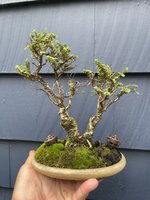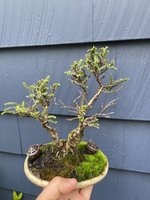badatusernames
Omono
WELLLLLLP
You've either opened this thread unawares, or you know this species and are getting ready for the typical questions. So let's just dive in, because the best advice for Hokkaido Elm appears to be "don't do it", but that advice would only have been useful to me a year ago when I was sure that whatever "difficult species" meant was something I could overcome. I do see another thread on the subject was bumped recently, but I didn't see what I was looking for there so thought I'd start this one for mine.
Here's the tree.

So, I knew going into it that the branches break like pretzel sticks. Wiring is virtually impossible. But clip and grow on a tree of this size? Seems reasonable.
As you can see, however, it leafed out improperly, or not quite vigorously, or late, or something. Leaves aren't where they're supposed to be and there aren't really as many as I'd like.
On TOP of that, the branch in the back is real bad off:


It's not completely dead, as you can see by the new growth, but all that ramification, all those branches above that new growth? Probably gone, based on what I've read on the species.
When I try to find information, I mostly find information about Chinese elm with an aside for Hokkaido elm. When I find Hokkaido elm specific information, it's typically people imploring others not to waste their time with the species. However, I did hear via word of mouth that there may be an element of controlling growth in spring that resulted in what we see here: all the energy going to the main two tallest branches of that trunk, and virtually none going to the third, shorter, smaller one in the rear.
Does anyone know the trick for these? I'd love to keep messing with it even if it's a dead end, because frankly I still find it quite beautiful. It may never be perfect, but I think making it enjoyable to look at might be achievable if one keeps on top of the growth.
You've either opened this thread unawares, or you know this species and are getting ready for the typical questions. So let's just dive in, because the best advice for Hokkaido Elm appears to be "don't do it", but that advice would only have been useful to me a year ago when I was sure that whatever "difficult species" meant was something I could overcome. I do see another thread on the subject was bumped recently, but I didn't see what I was looking for there so thought I'd start this one for mine.
Here's the tree.

So, I knew going into it that the branches break like pretzel sticks. Wiring is virtually impossible. But clip and grow on a tree of this size? Seems reasonable.
As you can see, however, it leafed out improperly, or not quite vigorously, or late, or something. Leaves aren't where they're supposed to be and there aren't really as many as I'd like.
On TOP of that, the branch in the back is real bad off:


It's not completely dead, as you can see by the new growth, but all that ramification, all those branches above that new growth? Probably gone, based on what I've read on the species.
When I try to find information, I mostly find information about Chinese elm with an aside for Hokkaido elm. When I find Hokkaido elm specific information, it's typically people imploring others not to waste their time with the species. However, I did hear via word of mouth that there may be an element of controlling growth in spring that resulted in what we see here: all the energy going to the main two tallest branches of that trunk, and virtually none going to the third, shorter, smaller one in the rear.
Does anyone know the trick for these? I'd love to keep messing with it even if it's a dead end, because frankly I still find it quite beautiful. It may never be perfect, but I think making it enjoyable to look at might be achievable if one keeps on top of the growth.


